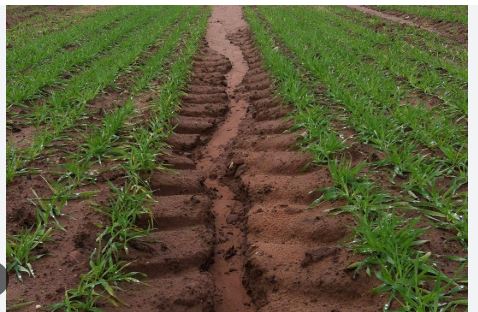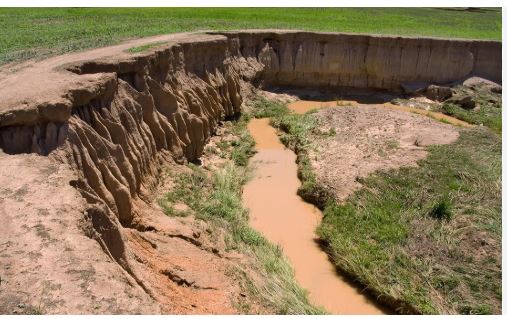
Soil erosion is the displacement of topsoil or surface layers from the land, driven by natural forces like water, wind, or ice, and human activities. It strips away nutrient-rich soil, reducing fertility and threatening agricultural productivity. This process also harms ecosystems by increasing sedimentation in waterways, disrupting aquatic life.
Erosion occurs through various processes, often starting with the detachment of soil particles and their transport by external forces. It is most severe in areas with sparse vegetation, steep slopes, or disturbed land, where soil is exposed. Factors like heavy rainfall, strong winds, or improper land management accelerate the loss of valuable topsoil.
The impacts of soil erosion are far-reaching, diminishing crop yields, degrading land quality, and contributing to environmental issues like desertification. It can also damage infrastructure by destabilizing slopes or clogging drainage systems. Economically, it burdens farmers with reduced productivity and costly restoration efforts.
Preventing soil erosion requires sustainable practices that protect soil integrity. Planting vegetation, using cover crops, or maintaining natural buffers stabilizes soil and reduces runoff. Structural measures like terraces or barriers can also slow erosion, preserving land for future use. Understanding the different types of soil erosion is crucial for implementing effective land management and conservation strategies.

Types of Soil Erosion
Splash Erosion
Splash erosion occurs when raindrops strike bare soil, dislodging particles and creating small craters. The kinetic energy of raindrops (especially during intense storms) breaks soil aggregates, splashing particles up to 3 feet away. It is the initial stage of water erosion, most severe on slopes with exposed soil. Impacts include reduced soil structure and increased runoff, leading to further erosion types. Common in agricultural fields without cover crops, it can be mitigated by mulching or maintaining vegetation cover.
Sheet Erosion
Sheet erosion involves the uniform removal of thin layers of topsoil across a large area by overland water flow, often during heavy rainfall. It occurs on gentle slopes where water moves as a shallow, continuous sheet, stripping nutrient-rich soil. Difficult to detect due to its even distribution, it leads to significant fertility loss over time. Common in tilled farmlands, it can be reduced by contour plowing, terracing, or planting ground cover to slow water movement.
Rill Erosion
Rill erosion develops when runoff water concentrates into small, shallow channels (rills) less than 30 cm deep, cutting into the soil surface. It occurs on moderate slopes where water flow gains enough velocity to carve defined paths. Rills can transport significant soil and deepen if unchecked, progressing to gully erosion. Prevalent in cultivated fields, it can be prevented by contour farming, strip cropping, or installing barriers to disrupt water flow.
Gully Erosion
Gully erosion is an advanced form of rill erosion, where concentrated runoff creates deep, wide channels (over 30 cm) that cannot be smoothed by regular tillage. It occurs on steep slopes or areas with intense water flow, removing large volumes of soil and altering landscapes. Gullies disrupt agriculture, damage infrastructure, and increase sedimentation in rivers. Common in deforested or overgrazed areas, it can be controlled by check dams, revegetation, or diverting runoff.
Streambank Erosion
Streambank erosion involves the removal of soil along riverbanks or stream channels due to flowing water, especially during floods or high-velocity currents. It is driven by hydraulic action, abrasion, and undercutting, destabilizing banks and widening channels. Impacts include loss of riparian land, increased sediment loads, and habitat destruction. Common in areas with cleared vegetation or altered water flows, it can be mitigated by planting riparian buffers or installing bank stabilization structures like gabions.
Tunnel Erosion
Tunnel erosion occurs when water infiltrates subsurface soil layers, creating underground channels or pipes that collapse, forming gullies. It is common in dispersive soils (e.g., sodic soils) with high clay content, where water erodes tunnels beneath the surface. Often triggered by improper land management or heavy rainfall, it leads to severe soil loss and land degradation. Prevalent in semi-arid regions, it can be prevented by improving soil structure with gypsum or maintaining vegetative cover.
Wind Erosion
Wind erosion involves the detachment and transport of loose, dry soil particles by wind, primarily in arid or semi-arid regions with sparse vegetation. Fine particles like silt and sand are lifted (suspension), bounced (saltation), or rolled (surface creep), leading to topsoil loss and air pollution. It degrades soil fertility and can create dust storms. Common in overgrazed or tilled deserts, it can be reduced by windbreaks, cover crops, or reduced tillage.
Tillage Erosion
Tillage erosion results from mechanical soil movement during plowing or cultivation, particularly on slopes. Soil is displaced downslope by tillage tools, accumulating at field boundaries or lower slopes, while exposing subsoil uphill. It reduces topsoil depth and fertility, exacerbating other erosion types. Common in intensive agriculture, it can be mitigated by adopting no-till or minimum-till practices, contour plowing, or terracing to minimize soil displacement.
Coastal Erosion
Coastal erosion involves the removal of soil and sediment along coastlines by wave action, tidal currents, or storm surges. It is driven by hydraulic pressure, abrasion, and chemical weathering, eroding cliffs, beaches, and dunes. Impacts include land loss, property damage, and altered coastal ecosystems. Exacerbated by sea-level rise and human activities like dredging, it can be managed with seawalls, groins, or beach nourishment to stabilize shorelines.
Glacial Erosion
Glacial erosion occurs when moving glaciers scrape and transport soil, rocks, and sediment, reshaping landscapes. Processes include abrasion (grinding) and plucking (lifting bedrock), creating U-shaped valleys and moraines. It is significant in polar and mountainous regions, altering soil distribution and exposing new surfaces. While natural, its impacts on soil are long-term, with limited mitigation due to the scale of glacial movement.
Gravitational Erosion
Gravitational erosion, or mass wasting, involves the downslope movement of soil and rock under gravity, often triggered by water saturation, earthquakes, or human activity. Forms include landslides, mudflows, and slumps, rapidly removing large soil volumes. It causes significant land degradation and hazards in hilly or mountainous areas. Mitigation includes slope stabilization, drainage systems, and avoiding deforestation on steep slopes.
Interrill Erosion
Interrill erosion is the removal of soil between rills by raindrop impact and shallow overland flow, complementing rill erosion. It detaches particles via splash and transports them downslope in thin sheets, contributing to topsoil loss. Common on cultivated slopes, it reduces soil fertility and increases runoff. Prevented by mulching, cover crops, or conservation tillage to protect soil surfaces from rain impact.
Anthropogenic Erosion
Anthropogenic erosion results from human activities like deforestation, overgrazing, mining, or construction, accelerating natural erosion processes. It removes topsoil through improper land use, exposing subsoil and degrading land. Impacts include reduced agricultural yields, sedimentation, and habitat loss. Common in urbanizing or intensively farmed areas, it can be mitigated by sustainable land management, reforestation, and erosion control practices like contour bunding.
Freeze-Thaw Erosion
Freeze-thaw erosion occurs in cold climates where water in soil or rock freezes, expands, and thaws, fracturing and dislodging soil particles. Repeated cycles loosen soil, making it susceptible to runoff or wind erosion. It is prevalent in mountainous or temperate regions, causing soil instability and rockfalls. Mitigation includes maintaining vegetation cover or using mulch to insulate soil and reduce freeze-thaw cycles.